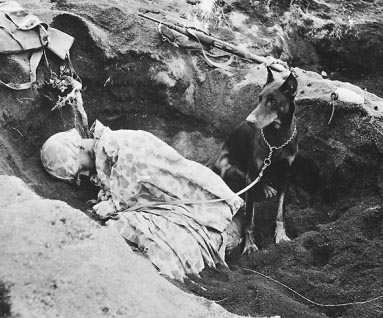![]() The Pacific War Online Encyclopedia
The Pacific War Online Encyclopedia
|
| Previous: War Crimes | Table of Contents | Next: War Games |

Naval Historical Center #NH 104294
The Marine Corps trained a small number of war dogs for service in the Pacific. They were used at Bougainville and Peleliu but saw their most extensive service on Guam, where 60 war dogs went ashore and twenty were killed or went missing. Some war dogs served as messenger dogs while others were used as sentries or at the "point" of patrols, where their superior senses often negated surprise by the enemy.
A Marine on Bougainville recalled taking the dogs on patrol (Gailey 1991):
One dog was a German Shepherd female, the other was a Doberman male, and they had three men with them. The third man handled the dogs all the time in the platoon area prior to our going on patrol — petting the dogs, talking to them, and being nice to them. The other two handlers — one would go to the head of the column and one would go to the rear with the female messenger dog.... If the dog in front received enemy fire and got away he could either come back to me or circle to the back of the column. If I needed to send a message I would write it, give it to the handler, and he would pin it on the dog's collar. He would clap his hands and say, "Report," and the doc would be off like a gunshot to go to the third man in the rear who had handled him before the patrol.
U.S. Marine Corps. Via ibiblio.org
War dogs sometimes were used to flush out hidden Japanese, as at Guam and at Mount Suribachi on Iwo Jima, but took heavy casualties
doing so.
War dogs were recruited from civilian owners and
screened to eliminate unhealthy, high-strung or vicious animals, then
extensively trained to work with their Marine handlers, with whom they
generally formed a close bond. Mongrels proved best and German
shepherds next best, while many Dobermans were too high-strung to
serve effectively as war dogs. Male dogs were more effective than
females.
Marine commanders
were skeptical that war dogs could be safely demilitarized and returned
to their former owners following the Japanese surrender, but the dogs' handlers
succeeded in getting authorization to make the attempt. Most of the
dogs proved able to re-adapt to civilian life, but a small number could
not be demilitarized and had to be euthanized.
Smaller dogs kept as mascots were distinct from war dogs, but were highly prized by some units and probably contributed significantly to morale. They were particularly popular with ship's companies, probably from the days when they would have served a valuable function as ratters. The affection held for these beasts is demonstrated by the fact that Lexington's dog was among the survivors evacuated before the crippled carrier was scuttled.
The Japanese made limited use of dogs in their operations. Coast watchers on Guadalcanal
discovered that the Japanese were making use of watch dogs, and they
began to lay citronella or the droppings of their own unneutered dogs
across their trails. However, the Japanese on the island never actually
attempted to hunt the coast watchers using bloodhounds.
References
The Pacific War Online Encyclopedia © 2009, 2011, 2013-2014 by Kent G.
Budge. Index